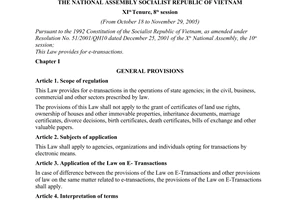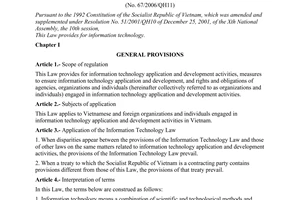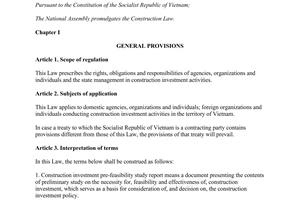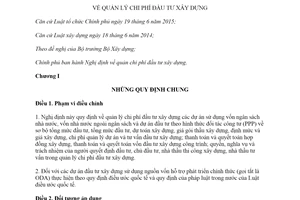Nội dung toàn văn Circular 12/2019/TT-BXD development of database systems for construction input norms
|
MINISTRY OF
CONSTRUCTION |
SOCIALIST
REPUBLIC OF VIETNAM |
|
No. 12/2019/TT-BXD |
Hanoi, December 26, 2019 |
CIRCULAR
GUIDING DEVELOPMENT AND ADMINISTRATION OF DATABASE SYSTEMS FOR CONSTRUCTION INPUT NORMS, COSTS AND OUTPUT PRICE INDICES
Pursuant to the Law on Construction No. 50/2014/QH13 dated June 18, 2014;
Pursuant to the Government's Decree No. 81/2017/ND-CP dated July 17, 2017, defining the functions, tasks, powers and organizational structure of the Ministry of Construction;
Pursuant to the Government’s Decree No. 68/2019/ND-CP dated August 14, 2019 on administration of investment and construction expenses.
Upon the request of the Director of the Construction Economics Department;
The Minister of Construction hereby promulgates the Circular providing instructions on development and administration of database systems for construction input norms, costs and output price indices.
Chapter I
GENERAL PROVISIONS
Article 1. Scope
This Circular regulates development and administration of database of construction input norms, costs and output price indices, including provision, collection, processing, update, storage, protection and security of data contained in, exploitation, use, control and operation of, database systems.
Article 2. Subjects of application
1. This Circular shall apply to entities and persons involved in development and administration of databases of construction input norms, costs and output price indices which serve the purposes of management of costs of investment and construction projects funded by the state budget and non-budgetary capital, and public-private partnership (PPP) investment projects, except investment and construction projects mentioned in the list of state secret, national security and defence projects.
2. Entities and persons not mentioned in clause 1 of this Article are encouraged to apply regulations laid down herein.
Article 3. Principles of development and administration of database systems for construction input norms, costs and output price indices
1. System of databases of construction input norms, costs and output price indices must ensure accuracy, adequacy, synchronized connectivity, conformance to laws and requirements of different markets; must serve state management purposes on a timely basis and meet socio-economic growth demands.
2. Collected and supplementary data and information must ensure that they do not overlap or duplicate others. There must be close cooperation in collection of data and information. All available data and information must be exploited as much as possible. All funds and resources must be implemented in an effective, feasible and economical manner. Data and information already checked, treated and updated according to regulations in all systems of database of construction input norms, costs and output price indices must have the same legal value as those contained in paper documents.
3. These databases can help to improve construction productivity, competency and effectiveness in state economic regulation of investment in construction and development of urban areas, can contribute to preventing loss and waste arising from investment and construction activities.
4. Entities and persons shall be legally liable for data and information that they have provided or updated on each database system.
Article 4. Classification of data and information on construction input norms, costs and output price indices
1. Data and information about construction input norms, including:
a) Norms for use of building materials;
b) Norms of labor productivity;
c) Norms of performance of building machinery and equipment;
d) Norms for construction cost estimation;
dd) Norms of project management, investment and construction expenses;
e) Norms of indirect costs.
2. Data and information about construction costs, including:
a) Cost per unit and total cost of components of a construction project;
b) Costs of building materials;
c) Unit labour costs;
d) Per-shift machine and construction equipment costs;
dd) Unit construction costs.
3. Data and information about construction output price indices, including:
4. Data and information about construction projects and contracts, including:
a) Project information;
b) Total investment amount;
c) Construction cost estimation;
d) Successful bid price;
dd) Contract value;
e) Closing or settlement costs.
5. Details about these data and information are provided in Appendix I herein.
6. Data and information about construction input norms, costs and output price indices are encoded according to the code system given in the Appendix II herein.
Chapter II
PROVISION, COLLECTION, UPDATE, PROCESSING, STORAGE, PROTECTION OF CONDIDENTIALITY OF DATA AND INFORMATION, EXPLOITATION AND USE OF DATA AND INFORMATION ABOUT CONSTRUCTION INPUT NORMS, COSTS AND OUTPUT PRICE INDICES
Article 5. Collection and provision of data and information
1. Provincial-level Departments of Construction shall be responsible for collecting, consolidating and providing a sufficient amount of data and information specified in Article 4 herein under their jurisdiction at respective localities in order for database system administrators to update systems of database of construction input norms, costs and output price indices.
2. Construction authorities affiliated to ministries having jurisdiction over specialized construction works shall be responsible for collecting, consolidating and providing a sufficient amount of data and information specified in Article 4 herein under their respective jurisdiction in order for database system administrators to update systems of database of construction input norms, costs and output price indices.
3. Construction project owners, management units and other entities involved in implementation of projects funded by state capital and PPP investment projects shall be responsible for providing data and information about investment and construction projects and contracts as provided in Article 4 herein in order for database system administrators to give updates to their database systems.
4. Construction authorities affiliated to ministries having jurisdiction over specialized construction works shall be responsible for collecting, consolidating and providing a sufficient amount of data and information specified in Article 4 herein under their respective jurisdiction in order for database system administrators to update systems of database of construction input norms, costs and output price indices.
5. Requirements for data and information provided as updates to databases shall be set out in detail as follows:
a) Data and figures shown in periodic and ad-hoc reports received from entities and persons must be certified by entities having competence in publishing them.
b) Data and figures shown as investigation or survey results must undergo acceptance tests conducted by competent entities.
c) Data and information providing updates to databases must be expressed in written documents, enclosing electronic data files which have to created by using formats and templates shown in Appendices hereto.
6. Data and information must be reported in an adequate, timely and accurate manner and must be appropriate to specific contexts of different regions. Whenever there are any revision or supplementation of sent data and figures, or any abnormality of data within a reporting period, entities and organizations must send explanatory notes in electronic or documentary form to database system administrators.
7. Regime for providing and updating data and information:
a) Provincial-level Departments of Construction shall assume responsibility for uploading data and information about building material costs on a monthly basis on database systems, not later than the first day of the following month; providing data and information about construction input norms, costs and output price indices not more than 10 days from the date of publication thereof.
b) Construction entities affiliated to ministries specialized in construction shall be responsible for providing data and information about construction input norms, costs and output price indices for the period of not more than 10 days from the publication date.
c) Project owners, management units and entities involved in implementation of project funded by state capital and PPP investment projects shall be responsible for providing data and information about investment and construction projects referred to in Article 4 herein within the duration of 10 days from the date of approval; providing data and information about construction contracts prescribed in Article 4 herein within the duration of 10 days from the signature date; providing data and information about closing or settlement value within the duration of 10 days from the date of approval of financial settlement of a construction work or project.
d) Persons and entities involved in management of investment and construction costs shall be responsible for collecting, consolidating and providing data and information specified in Article 4 herein within their appropriate ambit whenever new data or information arise.
Article 6. Consolidation, processing, update and disclosure of data and information by database system administrators
1. Database system administrators shall be responsible for periodically consolidating and updating data and information provided by entities and persons stated in clause 1, 2, 3 and 4 of Article 5 herein on database systems.
2. Data and information shall be updated and consolidated according to the following steps:
a) Receiving, checking, verifying and sorting out data and information.
b) Classifying data and information according to data fields shown in databases as provided in Article 4 herein.
c) Updating and consolidating data and information by using apps/software products authorized by the Ministry of Construction.
d) Checking whether data and information are successfully updated on databases.
3. With respect to data and information provided by entities or persons, where necessary, heads of entities and units receiving and processing data and information must establish advisory councils composed of experienced experts and administrators for inspection and assessment of these data and information.
4. In the course of processing of information, in case where any defect or error is found, and provided data and information are improper, entities providing data and information shall be responsible for clarifying, explaining and revising these defective or erroneous data and information, and providing impeccable ones to entities and units authorized to process data and information.
5. Mechanism for publishing data and information about construction input norms, costs and output price indices:
a) Data and information must be posted on a regular basis on the Ministry of Construction’s portal, including legislative documents related to construction input norms, costs and output price indices published by ministries or sectors under their respective jurisdiction; data and information about construction input norms, costs and output price indices formulated according to reports of localities and ministries specialized in construction works.
b) Data and information must be published and updated on a monthly or quarterly basis.
Article 7. Storage, custody and safekeeping of data and information
1. Database system administrators must apply managerial, professional and technical measures to information systems in order to protect and restore systems and data contents; ensure security and confidentiality for application systems and databases constituting systems, including database, system, application and physical layer security.
2. Database administrators shall be responsible for applying the information technology in order to ensure data are safely stored in databases in terms of:
a) Physical storage: Database systems must run in a stable manner
b) Logical organization: Data need to be safe according to principles and formats of corresponding databases, and provided that any deliberate damage to logical organization of data.
c) Protection of online information security and avoidance of loss of information from database systems.
d) Storage of digital data on server systems, and prevention of unauthorized access through security systems by using advanced methods and techniques.
3. Database administrators must provide solutions to maintaining integrity of data and information, periodic inspection and safety for the entire online information system.
4. Data backup:
a) Data archived in databases must be backed up into information storage devices on a periodic basis and stored according to technical, security and safety procedures and regulations prescribed in laws.
b) Data must be regularly backed up and stored according to regulations in force.
Article 8. Data and information security regimes
1. Database administrators shall be responsible for ensuring information safety and security, adopting organizational, operational, professional or technical solutions to ensuring data safety, security and cybersecurity.
2. Printing, duplication, delivery, transfer of data, storage, custody and provision of data and information must conform to data and information security regulations.
3. Database administrators must formulate specific regulations on rights to access and update data and information.
4. Persons updating and accessing databases shall be accorded certain access and update rights to specific data components, ensuring strict management of rights to access data and information available in database systems.
Article 9. Use and exploitation of data and information
1. Persons and entities shall be entitled to access, use and exploitation of data and information about construction input norms, costs and output price indices via Internet networks or websites, subject to the following regulations:
a) Accessing, using and exploiting the list of data and information about construction input norms, costs and output price indices.
b) Accessing, using and exploiting data and information about construction input norms, costs and output price indices according to laws that are widely disseminated and made know to the public.
2. Persons and entities shall be entitled to apply for grant of rights to access and use data and information other than those prescribed in clause 1 of this Article through Internet networks and websites. Database administrators can grant rights to access data and information about construction input norms, costs and output price indices to persons and entities submitting applications provided that such rights are relevant to users and purposes prescribed in regulations in force.
3. Entities and persons accessing, using and exploiting databases shall assume the following responsibilities:
a) Entering correct addresses and passwords; avoiding any disclosure of granted addresses and passwords.
b) Accessing, using and exploiting data and information within their delegated authority and avoiding illegal infringement upon databases; using data and information for predetermined purposes.
c) Managing contents of received data and information, avoiding providing them to entities and persons, unless otherwise permitted by database administrators.
d) Prohibiting any unauthorized change, erasure, deletion, cancellation, duplication, disclosure, display or movement of part or all of data and information; preventing development or spread of software programs that may cause adverse impacts or falsify databases of construction input norms, costs and output price indices; sending timely notices of any error or defect in provided data and information to database administrators.
dd) Complying with laws on protection of state secrets and Cybersecurity Law; bearing responsibility for any violation arising from access to, use or exploitation of data and information.
4. Access to, use and exploitation of data and information about construction input norms, costs and output price indices through Internet networks or websites must conform to regulations laid down in the Law on Electronic Transactions, the Law on Information Technology and other documents providing instructions about these Laws.
Chapter III
IMPLEMENTATION PROVISIONS
Article 10. Responsibilities of entities and units for databases of construction input norms, costs and output price indices
1. Ministry of Construction:
a) Designate Construction Economics Department affiliated to the Ministry of Construction as an administrator of databases of construction input norms, costs and output price indices;
b) Provide data and information included in the databases of construction input norms, costs and output price indices;
c) Develop, manage and take full control of nationwide databases of construction input norms, costs and output price indices;
d) Formulate and complete code and software systems used for managing databases of construction input norms, costs and output price indices;
dd) Provide instructions about tasks involved in and methods for setting up databases; using software products for management of databases; instructions about approaches to updating databases from ministries specialized in construction, provincial-level People’s Committees and related entities;
e) Inspect and assess implementation of regulations on development, management, use, operation and update of databases of construction input norms, costs and output price indices;
g) Provide regular funding from the state budget for management, operation and maintenance of databases of construction input norms, costs and output price indices in accordance with regulations in force.
2. Construction Economics Department controlled by Ministry of Construction:
a) Take charge of developing and managing software systems in a consistent manner in order to operate, use and exploitation of databases of construction input norms, costs and output price indices;
b) Inspect, speed up, instruct ministries, sectors and localities, persons and entities concerned nationwide about development, management, operating, use, exploitation and update of databases of construction input norms, costs and output price indices; act as a focal point specialized in receiving, processing and consolidating data and information about construction input norms, costs and output price indices reported or provided by ministries, sectors, localities, persons or entities concerned;
c) Provide instructions on how to access and provide data and information about construction input norms, costs and output price indices which support publication thereof by the Ministry of Construction;
d) Preside over and cooperate with Communications Center affiliated to the Ministry of Construction in formulating regulations on management and use of systems of information about construction input norms, costs and output price indices, organize training and career development courses in use of software products.
3. Communications Center, a subsidiary of the Ministry of Construction, shall be responsible for presiding over and cooperating with the Construction Economics Department in managing information technology technical infrastructure of databases of construction input norms, costs and output price indices; ensuring safety and security for databases.
4. Ministries specialized in construction:
Direct their affiliated construction authorities to collect, consolidate and provide data and information under their authority for database system administrators to provide updated data and information for databases of construction input norms, costs and output price indices in accordance with Article 5 herein.
5. People’s Committees of centrally-affiliated cities and provinces:
a) Direct provincial Departments of Construction to formulate regulations on management, use, exploitation, operation, update of local databases of construction input norms, costs and output price indices; regulations on information confidentiality and security; assign full-time employees having relevant expertise and qualifications to regularly provide, update, use, exploit and operate databases of construction input norms, costs and output price indices; carry out inspection and assessment of compliance with regulations on development, management, use, operation, exploitation and update of local databases of construction input norms, costs and output price indices; instruct and encourage entities, units and organization concerned under their management; instruct and push local entities, units and organizations concerned to implement reported contents in accordance with laws; widely publish email addresses on websites where persons and entities can send reports on data and information.
b) Provide regular funding from the state budget for collection, consolidation and provision of information for databases of construction input norms, costs and output price indices in accordance with regulations in force.
6. Construction project owners, management units and other entities involved in implementation of projects funded by state capital and PPP investment projects shall be responsible for providing data and information about construction procurement, construction project settlement for entities specialized in construction as assigned under Article 5 herein so that they can update their databases.
Article 11. Entry into force
1. This Circular shall enter into force on February 15, 2020.
2. In the course of implementing this Circular, if there is any query arising, persons and entities may send it to the Ministry of Construction to seek its decision on possible solutions./.
|
|
PP. MINISTRER |
------------------------------------------------------------------------------------------------------
This translation is made by THƯ VIỆN PHÁP LUẬT and
for reference purposes only. Its copyright is owned by THƯ VIỆN PHÁP LUẬT
and protected under Clause 2, Article 14 of the Law on Intellectual Property.Your comments are always welcomed



